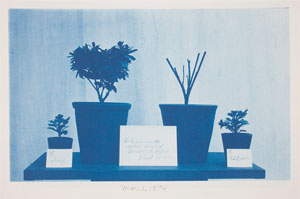Lace Samples, probably French, c.1905
The lace cyanotypes have been really interesting to research this semester. The first time I saw them in person I was struck by their scale. They are very large in comparison to the other cyanotypes created during the early 20th century. Their function was unclear to me, as they would not have been considered art when they were made. Perhaps they were used to sell the lace or maybe they were a reference for the manufacturer. The other important aspect I noticed when observing these objects was the amount of detail visible. In person, you can see every thread and stitch in both cyanotypes; it is almost like we are looking at the actual lace, lying on blue paper, rather than a print. Along with the beautiful details of the lace, many small imperfections can be seen. Among these glitches are the fact that the edges of the paper are very ragged and there are some discolorations at the top and bottom of prints. These details make me think that these cyanotypes were not defined as art when they were made. I am excited to see how the final exhibition looks.



 Sign up for WAM eNews
Sign up for WAM eNews